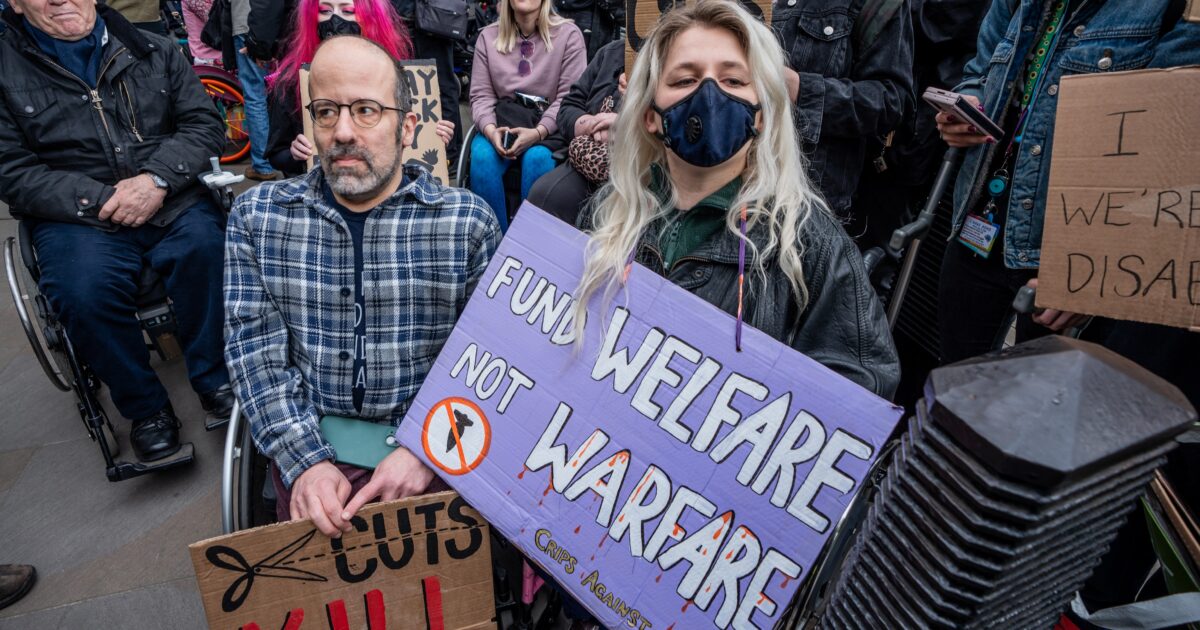Paywalls? Never. We think quality reporting should be free for everyone – and our supporters make that possible. Chip in today and help build people-powered media that everyone can access.
Labour’s welfare reform is not merely a green paper and legislative bill – it is an attack upon disabled people by the British state. On 1 July, the government will attempt to get its Universal Credit and Personal Independence Payment Bill through parliament because while spending on social security remains stable at around 11% of GDP, the state has decided it is too generous towards disabled people and would like to support us less. The state also believes that if a social security payment for people who cannot work exists, it will incentivise people to fraudulently say they cannot work. Both views are animated by disablist prejudices and unsupported by evidence.
The manner of the attack has been betrayal and ambush, with undemocratic legislative manoeuvring augmented by a coordinated campaign with their media partners. It is a moral cause to immiserate disabled people – we must hurry to do so! It’s almost grimly amusing to see how few of them understand the system they’re talking about, or disabled people’s lives.
Welfare ‘reform’ is a continuous revolution. Every few years, another iteration is vomited up as politicians close in on capital’s dream of finally ending any duty government has to the people. The reorientation of the ministry that oversees social security – the Department for Work and Pensions (DWP) – from one that notionally provided a safety net to an organisation predicated upon policing and persecuting those in poverty is close to complete. Note the name only refers to ‘work and pensions’. In case the institutional attitude was unclear, the 2001 Woodstock conference dropped a rather large clue: “malingering and illness deception”.
Generously funded by US insurance companies, New Labour slowly dripped out their plans as employment support allowance (ESA) was introduced, then the Tories and the Lib Dems came into power and turbocharged it by introducing personal independence payments (PIP). The cherry on top was Iain Duncan Smith’s universal credit (UC) – now workers would come under the cosh of the DWP’s sanctions regime.
Discussions between disabled peoples’ organisations and the Labour party – both in opposition and in government – turned out to be a mere smokescreen, a delaying tactic, a distraction. Labour’s true policies were kept away from us, then deployed as a moral crusade to save ourselves from ourselves. It is spectacularly patronising – a familiar dynamic for disabled people. This new paradigm of cruelty doesn’t begin to describe the alienation we feel from a state that has chosen to do this.
Disabled activists in DPAC (Disabled People Against Cuts) and others – not any statutory rights body or charity – brought the United Nations to this country to investigate. UN reports in 2017 and 2024 found grave and systematic human rights abuses of disabled people that amounted to a human catastrophe. In 2024, the UN identified further regression. Prime minister Keir Starmer seems intent on the trifecta.
The government’s concessions – exempting current PIP recipients from cuts to eligibility and rowing back on freezing the rate of health element of UC for current and some new claimants – are a product of political horse trading. They rest upon a redefinition disability not recognised anywhere – dubbed a global anomaly by Dr Jay Watts. The bill still means cuts and greater state intrusion into our lives. The bill will intensify and accelerate regression.
The toll on our mental and subsequently physical health is very apparent in our communities and in our loved ones. There is bewilderment and dismay, but there is a cold hard anger that has passed beyond reaction and into something we draw upon to wield against this assault.
Keir Starmer has enthusiastically embraced genocide abroad and now appears to be doing the same for democide at home. His administration has targeted us as he has targeted migrants and trans people, and in response we are in solidarity, we shall not be divided and ruled. This is a multigenerational struggle. We can hope those who come after us are in a better position, or at least can learn from mistakes we made. Not everyone who started this journey is still with us, the suicides caused by this system remain an open secret, activists crowdfunded to send a copy of John Pring’s The Department to every single MP. It appears most of them refused to read it.
We have an existential crisis of democracy. Politicians will continue to attack us and destroy our social safety net. There is no entity capable of taking power presently that will not attack us, so we’re in for the long haul. We need to get into the dirty business of building an entity that can take power for the left. I expect most people reading this are active in their communities – the next job we need to do is to turn to the people who aren’t active, hold out a friendly hand and simply say, “join the resistance”.
Rick Burgess is campaign lead for the Greater Manchester Coalition of Disabled People.
